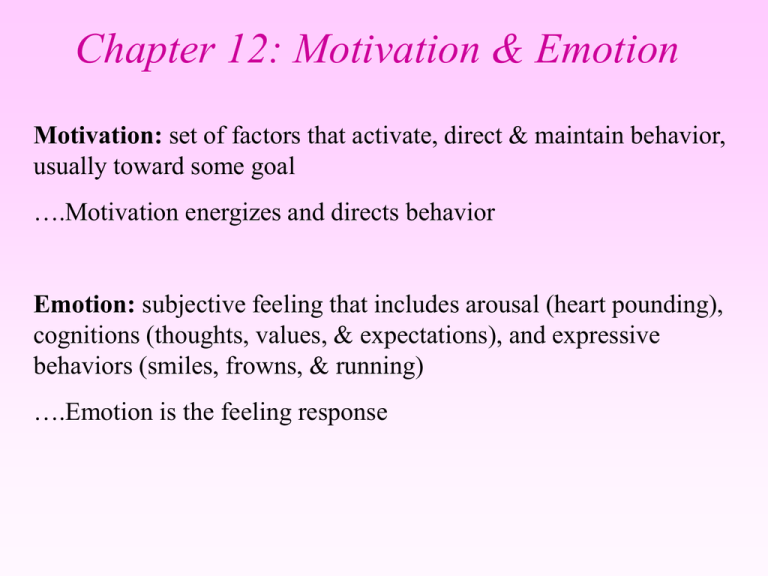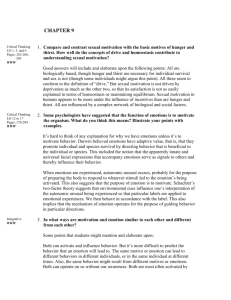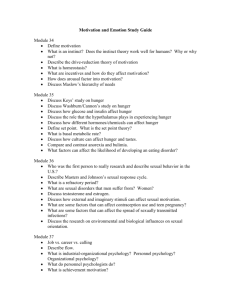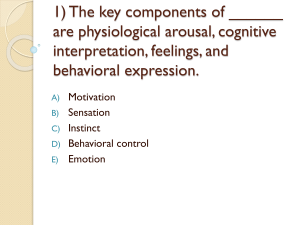
Chapter 12: Motivation & Emotion
Motivation: set of factors that activate, direct & maintain behavior,
usually toward some goal
….Motivation energizes and directs behavior
Emotion: subjective feeling that includes arousal (heart pounding),
cognitions (thoughts, values, & expectations), and expressive
behaviors (smiles, frowns, & running)
….Emotion is the feeling response
Instincts
Instincts: Unlearned, genetically programmed,
fixed action pattern of complex behavior by all
members of species
Name three instinctual behaviors by animals.
What instincts do humans have?
Theory of Motivation: Instinct/Evolution
Instinct/Evolution Theories: Explains behavior in
how it supports reproduction in the organism.
These behaviors are generally innate and
unlearned.
William McDougall: 18 human instincts (parental,
submission, curiosity, escape, reproduction, repulsion,
self-assertiveness, jealousy…)
Later turned into over 10,000
Critics
Theory of Motivation: Drive-Reduction
Drive-Reduction Theory: an organism is motivated to
engage in activities that reduce an internal drive state and
return to homeostasis
Drive: an internal state of tension that motivates an organism to
reduce tension
Homeostasis: balanced internal state
Lack of homeostasis – need – drive – motivate to act – homeostasis
Primary and secondary drives
Theory of Motivation: Arousal
Arousal Theory: Organisms are motivated to achieve and
maintain an optimal level of arousal. Prefer environments
that are more stimulating
Yerkes-Dodson model
• Low difficulty- high arousal
• Med difficulty- med arousal
• High difficulty- low arousal
Theory of Motivation: Incentive & Cognitive
Incentive Theory: being driven to perform a behavior because of some
external payoff…externals “pull” us in a certain direction
- Environmental cause of motivation
- Goal attainment
Intrinsic: internal need for achievement
Extrinsic: external reinforcement from
Expectancy: value
Cognitive Theory: motivation is affected by our attributions, thoughts,
expectations. Humans have the higher level thinking that may
override other theories of motivation
Theory of Motivation: Hierarchy of Needs
Maslow’s Hierarchy of Needs: being driven by an ascending
“needs” list
Achievement Motivation: TAT
thematic apperception test
Write down
what is
happening in
this picture.
Write a story
including
details.
nAch
Need for achievement (nAch): a social need that
directs a person to constantly strive for excellence
High nAch:
- Set challenging, but attainable goals
- - Willing to take risks
- Persist after failure
Achievement motivation appears to be learned
Parents- Encourage diff tasks
Praise and give appropriate rewards for success
Provide strategies for success
Encourage new challenges
Culture- Collectivist vs. Individualist societies
Biological Drives-Hunger
Internal Cues
• glucostatic theory of hunger-as glucose levels drop in the blood,
hunger signals are initiated
• Insulin works the opposite way (high=hunger)
• set point theory of hunger and weight-the idea that the body
tries to maintain a set weight
• Fat Cells- Fixed number throughout life
• Metabolism- genetic range for individuals
• brain messages
– ventromedial hypothalamus-when stimulated, it signals satiety (fullness)
– lateral hypothalamus-when stimulated, its signals hunger
Factors controlling hunger &
satiation
Glucose, hormones, and hunger
Weight Control
The thinning of Miss America
Trend in Body Mass Index (BMI) of Miss America Pageant Winners
24
BMI, kg/m² 23
•
22
•
21
• • ••• • • •
• •••• • • •
•• • • •
•
• •
•
•
•
•
• • • • • • •• •
World Health
•
Organization’s
•
cutoff point for
20
19
18
17
16
•
Trend line
•
•
undernutrition (18.5)
15
1920 1930 1940 1950 1960 1970 1980 1990 2000
Year of Pageant
Biological Drives-Thirst
Thirst
• Osmotic Thirst
• produced when intracellular fluids are depleted
• Volemic Thirst
• produced when extracellular fluids are depleted
Biological Drives-Sex
Internal Factors
• Brain mechanisms: hypothalamus regulates hormone
release which may play a role in sexual behavior
• Normal Sexual Response Cycle
• Hormones
• organize gender during gestation (ex: androgens masculinize
genitals in males)
• activate gender-specific development during puberty (ex:
breast development in women)
• their role in motivating sexual intercourse is unclear
External Factors and Signals
• Pheromones: odors which elicit a specific response in
members of the same species
Emotions
Defined
• positive or negative feelings aroused by stimuli
in the environment
Function
• enrich life
• increase readiness for fight or flight
Basic Emotions: Acceptance, anger,
anticipation, disgust, joy, fear, sadness, surprise
Experiencing Emotion
Facial emotions are universal: They are expressed so
early and by all cultures, that theorists feel emotions are
innate (inborn).
Facial Feedback Hypothesis: states that feedback from
facial muscles affects our experienced emotion
Gender Differences
• women report experiencing more emotion than men
• women are more comfortable experiencing emotion than men
Physical Components of Emotions
Autonomic Nervous System Activation
• Some differences in activation are noted with specific
emotions
• ex: fear shows lower blood pressure and anger shows
increases cardiovascular changes
Polygraph: an electronic device that measures
physiological activation that some believe are
related to deception (very unreliable)
Brain Mechanisms in Emotion
Limbic System
• Amygdala: associated with fear, anxiety, and rage
• Hippocampus: important in the processing of memories
• Hypothalamus: begins a cascade of hormonal changes to perceived
threats in the environment
Theories of Emotions: chart
Theories of Emotions
James-Lange
• Theory that states that physiological arousal
precede and cause the sensation of emotion
Cannon-Bard
• Theory that states that physiological arousal and
emotional feelings occur simultaneously
Schacter-Singer (2 factor)
• Undifferentiated arousal that we cognitively
interpret by looking at the (stimulus and the
arousal)
The Expression of Emotions
Facial Expression: there is evidence that facial
expressions of various emotions are universal
(anger, disgust, happiness, fear, surprise, sadness)
Body Language/Movements/Gestures
• ex: Thumbs up to indicate “A-OK”
Tone of Voice/Rate of Speech
• ex: pitch of voice increases when experienced
emotion increases
Display Rules
Cultural norms which prescribe who can display
what emotions
• ex: In our society, we are more accepting of men
feeling anger and women feeling sadness
Theories of emotions
Catharsis
Relative depravation
Adaptation model
Opponent process
Feel good, do good phenomenon
Happiness
Sources•
•
•
•
•
•
•
•
•
Relationship with children
Friends
Contributing to others’ lives
Relationship with spouse/partner
Degree of control over your life
Leisure time activities
Relationship to parents
Religious
Holidays
Things to do to improve mood
Talk to someone
Listen to music
Pray/meditate
Help others in need
Take a bath
Play with a pet
Exercise
Go out with friends
Eat
Take a drive
8 steps to a more satisfying life
Count you blessings
Practice acts of kindness
Savor life’s joys
Thank a mentor
Learn to forgive
Invest time in family/friends
Take care of your body
Develop strategies for coping with
stress/hardships.








